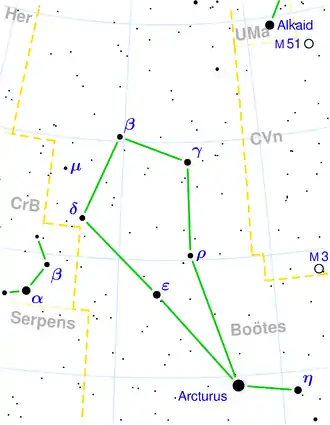NGC 5522
NGC 5522 ist eine 13,4 mag helle Spiralgalaxie mit aktivem Galaxienkern vom Hubble-Typ Sb im Sternbild Bärenhüter und etwa 205 Millionen Lichtjahre von der Milchstraße entfernt.
| Galaxie NGC 5522 | |
|---|---|
 | |
| SDSS-Aufnahme | |
| AladinLite | |
| Sternbild | Bärenhüter |
| Position Äquinoktium: J2000.0, Epoche: J2000.0 | |
| Rektaszension | 14h 14m 50,4s[1] |
| Deklination | +15° 08′ 49″[1] |
| Erscheinungsbild | |
| Morphologischer Typ | Sb[1] |
| Helligkeit (visuell) | 13,4 mag[2] |
| Helligkeit (B-Band) | 14,2 mag[2] |
| Winkelausdehnung | 1,8′ × 0,4′[2] |
| Positionswinkel | 50°[2] |
| Flächenhelligkeit | 12,9 mag/arcmin²[2] |
| Physikalische Daten | |
| Rotverschiebung | 0.015254 ±0.000030[1] |
| Radialgeschwindigkeit | 4573 ±9 km/s[1] |
| Hubbledistanz vrad / H0 |
(205 ± 14) · 106 Lj (62,9 ± 4,4) Mpc [1] |
| Geschichte | |
| Entdeckung | Wilhelm Herschel |
| Entdeckungsdatum | 19. März 1787 |
| Katalogbezeichnungen | |
| NGC 5522 • UGC 9116 • PGC 50889 • CGCG 103-125 • MCG +03-36-89 • IRAS 14124+1522 • GC 3814 • H III 644 • LDCE 1047 NED003 | |
Sie wurde am 19. März 1787 von Wilhelm Herschel mit einem 18,7-Zoll-Spiegelteleskop entdeckt,[3] der sie dabei mit „vF, vS, E, confirmed with 300 power“[4] beschrieb. In seinen Notizen führte er ergänzend aus: „vF, vS, E, 300 confirmed it, but shewed two small round patches united, which seemed to be like vF aberrations of two stars without the stars. I viewed them with many different adjustments of the focus“[4].
Weblinks
Einzelnachweise
- NASA/IPAC EXTRAGALACTIC DATABASE
- SEDS: NGC 5522
- Seligman
- Auke Slotegraaf: NGC 5522. Deep Sky Observer's Companion, abgerufen am 12. März 2016 (englisch).
This article is issued from Wikipedia. The text is licensed under Creative Commons - Attribution - Sharealike. The authors of the article are listed here. Additional terms may apply for the media files, click on images to show image meta data.
